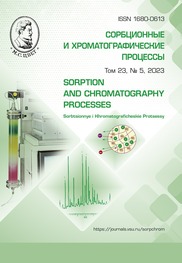Sorption of labile humus substances by structural-aggregate fractions of eroded chernozems
Abstract
Erosion processes are the main cause of degradation of chernozems, which occurs mainly as a result of the loss of soil organic matter and deterioration of the structural and aggregate state. The main part of organic carbon (Corg.) is concentrated in macroaggregates, therefore the destruction of macroaggregate fractions is the main cause of loss of Corg. during the development of erosion processes. The ability of soils to maintain a water-resistant structure is due to the sorption of humus substances, which have amphiphilic properties in them. To the greatest extent, such properties are possessed by young fractions of labile humus substances (LHS), present in an adsorbed state in microaggregates. Consequently, the quantitative content of LHS in structural-aggregate fractions is a reliable indicator of their anti-erosion resistance.
The goal of the research was the evaluation of the role of adsorbed LHS in the structural-aggregate fractions of chernozems in relation to their anti-erosion resistance.
Objectives: conduct field research of eroded chernozems; to select soil samples and conduct a series of laboratory studies of these samples for identification of the sorption properties of structural-aggregate fractions in relation to Corg. and LHS; to prove that the sorption of LHS by structural-aggregate fractions plays a significant role in maintaining the water-resistant structure of chernozems.
It has been established that in eroded chernozems there is a degradation of the structural-aggregate state, accompanied by deterioration of microstructure, a decrease in the number of mesoaggregates and the coefficient of structure, as well as the loss of a water-resistant structure. It has been shown that the sorption of LHS by structural-aggregate fractions plays a significant role in maintaining the water-stable structure of chernozems. It was established that the main role in the sorption of Corg. belongs to mesoaggregates with the size of 5-1 mm, which quickly lost by the soil during the development of erosion processes.
Downloads
References
Gusarov A.V., Golosov V.N., Sharifullin A.G., Gafurov A.M. Contemporary trend in erosion of arable southern chernozems (haplic chernozems pachic) in the west of Orenburg oblast (Russia). Eurasian Soil Science. 2018; 5 (51): 561-575. https://doi.org/10.1134/S1064229318050046
Plotnikova O.O., Demidov V.V., Lebedeva M.P. Deystviye melkovodnykh potokov na poverkhnostnyye gorizonty chernozema tipichnogo razlichnoy stepeni smytosti. Byulleten pochvennogo instituta im. V. V. Dokuchayeva. 2018; 91: 85-109. https://doi.org/10.19047/0136-1694-2018-91-85-109
Semenov V.M., Kogut B.M. Pochvennoye organicheskoye veshchestvo. GEOS. 2015; 233. (In Russ.)
Shpedt A.A., Zharinova N.Y., Trubnikov Y.N. Agrogenic degradation of soils in Krasnoyarsk forest-steppe. Eurasian Soil Science. 2017; 10 (50): 1209-1216. https://doi.org/10.1134/S106422931710012X
Zaydelman F.R. Zashchita pochv ot degradatsii. Vestnik Rossiyskoy akademii nauk. 2008; 78(8): 693-703. (In Russ.)
Kogut B. M. Otsenka urovney erodirovannosti chernozemov po otnositelnoy stepeni ikh gumusirovannosti. Byulleten Pochvennogo instituta im. V.V. Dokuchayeva. 2015; 78: 59-69. (In Russ.)
Molchanov E.N., Savin I.Y., Bulgakov D.S., Yakovlev A.S., Makarov O.A. National approaches to evaluation of the degree of soil degradation. Eurasian Soil Science. 2015; 11 (48): 1268-1277. https://doi.org/10.1134/S1064229315110113 (In Russ.)
Gosudarstvennyy (natsionalnyy) doklad o sostoyanii i ispolzovanii zemel v Rossiyskoy federatsii v 2017 godu.
Kuznetsov M.S., Glazunov G.P. Eroziya i okhrana pochv. Kolos. 2004; 352. (In Russ.)
John B., Yamashita T., Ludwig B., Flessa H. Storage of organic carbon in aggregate and density fractions of silty soils under different types of land use. Geoderma. 2005; 128: 63-79.
Six J., Paustian K., Elliott E. T., Combrink C. Soil structure and soil organic matter: I. Distribution of aggregate size classes and aggregate associated carbon. Soil Sci. Soc. Am. J. 2000; 64: 681-689.
Semenov V.M., Ivannikova L.A., Semenova N.A., Khodzhaeva A.K., Udal'tsov S.N. Organic matter mineralization in different soil aggregate fractions. Eurasian Soil Science. 2010; 2 (43): 141-148. https://doi.org/10.1134/S1064229310020031
Oades J.M., Waters A.G. Aggregate hierarchy in soils. Australian J. Soil Res. 1991; 29(6): 815-828.
Schulten H.R., Leinweber P. New insights into organic-mineral particles: composition, properties and models of molecular structure. Biology Fertility Soils. 2000; 30: 399-432.
Milanovskiy E.Yu. Gumusovyye veshchestva pochv kak prirodnyye gidrofobno-gidrofilnyye soyedineniya GEOS. 2009; 186. (In Russ.)
Milanovskii E.Yu., Shein E.V. Functional role of amphiphilic humus components in humus structure formation and soil genesis. Eurasian Soil Science. 2002; 10(35): 1064-1075.
Wershaw R.L. Model for humus in soils and sediments. Environmental Science and Technol. 1993; 27: 814-816.
von Wandruszka R. The micellar model of humic acid: evidence from pyrene fl uorescence measurements. Soil Sci. 1998; 163: 921-930.
Wershaw R.L. Molecular aggregation of humic substances. Soil Sci. 1999; 164: 803-813.
Kleber M., Sollins P., Sutton R. A conceptual model of organo-mineral interactions in soils: self-assembly of organic molecular fragments into zonal structures on mineral surfaces. Biogeochemistry. 2007; 85: 9-24.
Jastrow J.D., Miller R.M., Boutton T.W. Carbon dynamics of aggregate-associated organic matter estimated by carbon-13 natural abundance. Soil Sci. Soc. Am. J. 1996; 60: 801-807.
Milanovskii E.Yu., Shein E.V. Functional role of amphiphilic humus components in humus structure formation and soil genesis. Eurasian Soil Science. 2002; 10(35): 1064-1075.
Klassifikatsiya i diagnostika pochv SSSR. Kolos.1977; 221. (In Russ.)
World reference base for soil resources 2014. International soil classification system for naming soils and creating legends for soil maps. World Soil Resources Reports No. 106. FAO. Rome.
Shcheglov D.I., Gromovik A.I., Gorbunova N.S. Osnovy khimicheskogo analiza pochv. Izdatelskiy dom VGU. 2019; 332. (In Russ.)
Bronick C.J., Lal R. Soil structure and management: a review. Geoderma. 2005; 124: 3-22.
Six J., Bossuyt H., Degryze S., Denef K. A history of research on the link between (micro) aggregates, soil biota, and soil organic matter dynamics. Soil Tillage Res. 2004; 79: 7-31.
Angers D.A., Recous S., Aita C. Fate of carbon and nitrogen in water-stable aggregates during decomposition of 13C15N-labeled wheat straw in situ. European J. Soil Sci. 1997; 48: 295-300.
Gale W.J., Cambardella C.A. Carbon dynamics of surface residue – and root-derived organic matter under simulated notill. Soil Sci. Soc. Am. J. 2000; 64: 190-195.
Bossuyt H., Six J., Hendrix P.F. Aggregate-protected carbon in no-tillage and conventional tillage agroecosystems using carbon-14 labeled plant residue. Soil Sci. Soc. Am. J. 2002; 66: 1965-1973







